Many people assess humor and the funny using the same litmus test employed by Justice Potter Stewart in the 1964 obscenity case “Jacobellis v. Ohio.” In regards to hard-core pornography, Stewart famously stated “I know it when I see it.” While I have no knowledge of Justice Stewart’s expertise in this particular subject, I do tend to think that the ability to make snap judgments stems from experience. That is one reason why so many of us feel capable of instantly ascertaining what is funny and what is not. We’ve spent our whole lives laughing, so we believe that we know it when we see it.
Technically speaking, of course, comedy is also a performance structure. (And if you don’t know an academic when you see one, it’s possible to spot a scholar through the use of such phrases as “technically speaking” and “performance structure.”)
I’ve been intimately involved with one particular Absurdist comedy of late, and it’s reminded me of how some of the best comedies question what and how comedy works, and whether we should know comedy when we see it. Last year I joined with some former colleagues from the Stanford and Berkeley doctoral programs in performance to found The Collected Works and our inaugural project is Princess Ivona, a 1935 play by Polish literary legend Witold Gombrowicz. (While the text is European, I trust that staging this in San Francisco qualifies it as “Humor in America.”)
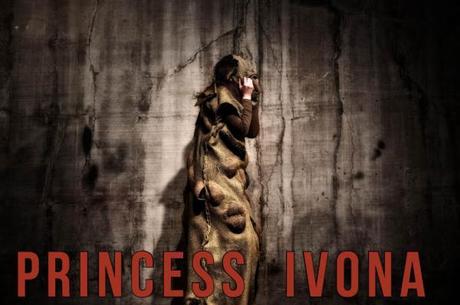
I’ve noticed throughout the production process that Princess Ivona brings to the fore our uneasiness surrounding comedy and our desire to be on the winning side when it comes to mockery and the mocked. On the lower end of the social hierarchy, there are aunts in the first act, concerned that they are being teased…
2nd AUNT: Your Highness is laughing at us of course. You are welcome to, I am sure.
…and courtiers in the second act, determined to tease the court newcomer, only to find that the tables have been turned on them.
2nd LADY: I understand now. You have arranged it all to show us up. What a joke!
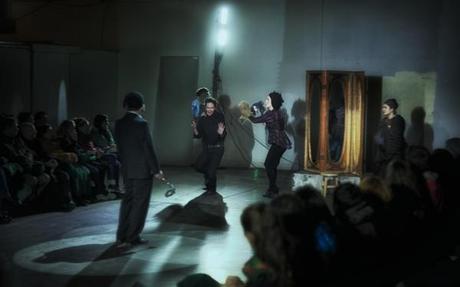
Carnival at Court. Image by Jamie Lyons.
In the world created by Gombrowicz, as well as our own, the fear of laughter is universal. King Ignatius himself is initially determined to view the intrusion of Ivona into the court as a joke, so he can join in with the enterprise and feel young again.
KING IGNATIUS: Joking, now I see. Just like his father. Practical jokes are about the only thing I still enjoy these days. The funny thing is, the simpler the joke, the more it pleases me. I really don’t know why. There are no jokes like the old jokes, what! The simpler they are, the younger they make me feel.
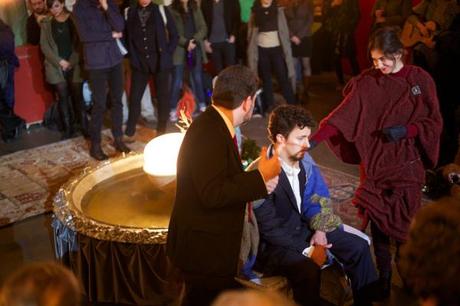
King Ignatius enjoys practical jokes. Image by Jamie Lyons.
Even Prince Philip, who brings Ivona into the court, frets that the comedy cannot be controlled.
PRINCE PHILIP: I may be wrong but it seems to me that they in fact no longer laugh at her but at me. Everyone is whispering and giggling. Is it a delusion?…I am not used to being a laughing stock or to having my actions and my feelings ridiculed.
Whether low or high, we all want there to be laughter, so long as it is aimed in the proper direction. In more than one way, the plot of Princess Ivona is of a joke that gets out of hand. Even the ending has elements of Monty Python in it, a serious silliness with a dramatically sharp edge. In a talkback last Friday, Professor Allen Kuharski of Swarthmore College mentioned how the first two performances reminded him more and more of the play’s connections to Moliere. He is correct. There’s the hiding, the court intrigue, and of course the skewering of fashionable morals and morality.
1st Aunt: Why don’t you try pole-vaulting? Other girls do…
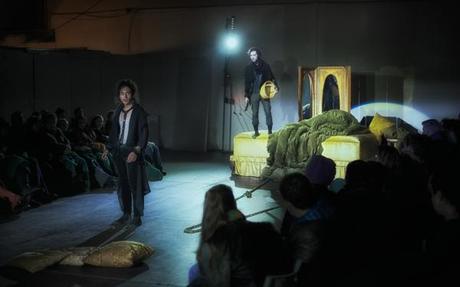
Prince Philip and Simon scheme. Image by Jamie Lyons.
Most comedies close with some sort of societal reconciliation — a restoration of order, whether it’s the young lovers leaving the forest in William Shakespeare’s A Midsummer Night’s Dream or the king imposing his will in Molière’s Tartuffe. With Princess Ivona, no order is restored without undergoing intense scrutiny.
Princess Ivona also raises many traditional comedic questions surrounding romantic unions. Will the dashing yet petulant Prince marry the newcomer to the court? Will he instead turn to the more conventionally attractive court insider? Indeed, does the whole premise of comedy depend upon having some sort of union?
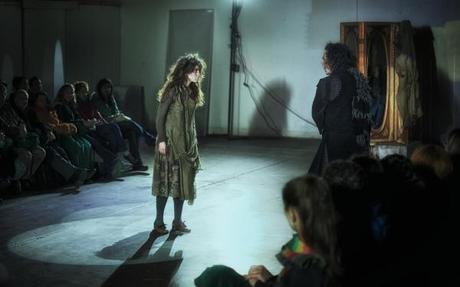
Prince Philip and Princess Ivona. Image by Jamie Lyons.
While more erudite than typical sitcom fare, some of the barbed witticisms in Princess Ivona share the same brand of crowd-pleasing insult humor. Our Wednesday night test audience was a group of arts-loving teenagers, and they appeared to respond most to the physical humor, such as the princess literally crawling over the prince rather than bowing on command, or the dance party that opens Act Two.
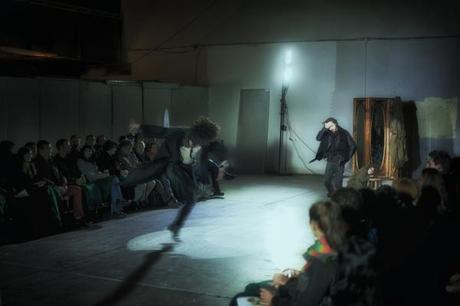
Prince Philip dances. Image by Jamie Lyons.
Comedy is not easy. In my role as the Lord Chamberlain, I’ve had to hide behind couches for interminable lengths of time, with my aching knees reminding me how comedy can be a harsh reminder of reality. Of course, my perspective is prejudiced. It is the Lord Chamberlain, after all, who sees that the situation is not a joke.
LORD CHAMBERLAIN: If it were only a joke! We must take all possible precautions Your Majesty.
And yet the Lord Chamberlain is wrong. If I may coin a phrase, there is nothing more dangerous than a really ugly joke. Princess Ivona demonstrates that deeply treacherous aspect of comedy, the lesson that even the best aimed barbs can wind up being boomerangs.
Sure, we may know comedy when we see it, but Gombrowicz asks whether we can trust in the results of a joke. My own answer is no, but then again, the untrustworthy element adds so much to the potential richness of humor. Just please don’t laugh at me for saying so…
Matthew Daube (Ph.D., Theater and Performance Studies, Stanford University) lectures for the Thinking Matters program at Stanford University. His dissertation, “Laughter in Revolt: Race, Ethnicity, and Identity in the Construction of Stand-up Comedy” argues for the recognition of stand-up comedy as a distinct performance mode that emerged in the United States following World War II, linked to issues of race and focused on the performance of self. He is particularly interested in the intersections between humor and the performance of identity, and has published articles on the use of ethnic stereotype by the Marx Brothers and the role of the audience in stand-up comedy. He is also a founding member of The Collected Works, presenting Princess Ivona through February 9th.
